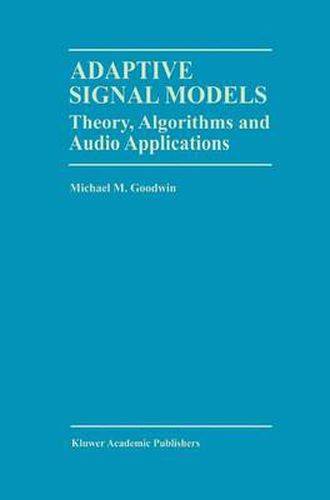Readings Newsletter
Become a Readings Member to make your shopping experience even easier.
Sign in or sign up for free!
You’re not far away from qualifying for FREE standard shipping within Australia
You’ve qualified for FREE standard shipping within Australia
The cart is loading…






This title is printed to order. This book may have been self-published. If so, we cannot guarantee the quality of the content. In the main most books will have gone through the editing process however some may not. We therefore suggest that you be aware of this before ordering this book. If in doubt check either the author or publisher’s details as we are unable to accept any returns unless they are faulty. Please contact us if you have any questions.
Presenting methods for deriving mathematical models of natural signals, this text covers the fundamentals of analysis - synthesis systems and signal representations. Some of the topics in the introduction include perfect and near-perfect reconstruction, the distinction between parametric and nonparametric methods, the role of compaction in signal modelling, basic and overcomplete signal expansions, and time-frequency resolution issues. These topics arise throughout the book as do a number of other topics such as filter banks and multi-resolution. The second chapter gives a detailed development of the sinusoidal model as a parametric extension of the short-time Fourier transform. This leads to multi-resolution sinusoidal modelling techniques in Chapter Three, where wavelet-like approaches are merged with the sinusoidal model to yield improved models. In Chapter Four, the analysis-synthesis residual is considered; for realistic synthesis, the residual must be separately modelled after coherent components (such as sinusoids) are removed. The residual modelling approach is based on psychoacoustically motivated nonuniform filter banks. Chapter Five deals with pitch-synchronous versions of both the wavelet and the Fourier transform; these allow for compact models of pseudo-periodic signals. Chapter Six discusses recent algorithms for deriving signal representations based on time-frequency atoms; primarily, the matching pursuit algorithm is reviewed and extended. The signal models discussed in the book are compact, adaptive, parametric, time-frequency representations that should be useful for analysis, coding, modification, and synthesis of natural signals such as audio.
$9.00 standard shipping within Australia
FREE standard shipping within Australia for orders over $100.00
Express & International shipping calculated at checkout
This title is printed to order. This book may have been self-published. If so, we cannot guarantee the quality of the content. In the main most books will have gone through the editing process however some may not. We therefore suggest that you be aware of this before ordering this book. If in doubt check either the author or publisher’s details as we are unable to accept any returns unless they are faulty. Please contact us if you have any questions.
Presenting methods for deriving mathematical models of natural signals, this text covers the fundamentals of analysis - synthesis systems and signal representations. Some of the topics in the introduction include perfect and near-perfect reconstruction, the distinction between parametric and nonparametric methods, the role of compaction in signal modelling, basic and overcomplete signal expansions, and time-frequency resolution issues. These topics arise throughout the book as do a number of other topics such as filter banks and multi-resolution. The second chapter gives a detailed development of the sinusoidal model as a parametric extension of the short-time Fourier transform. This leads to multi-resolution sinusoidal modelling techniques in Chapter Three, where wavelet-like approaches are merged with the sinusoidal model to yield improved models. In Chapter Four, the analysis-synthesis residual is considered; for realistic synthesis, the residual must be separately modelled after coherent components (such as sinusoids) are removed. The residual modelling approach is based on psychoacoustically motivated nonuniform filter banks. Chapter Five deals with pitch-synchronous versions of both the wavelet and the Fourier transform; these allow for compact models of pseudo-periodic signals. Chapter Six discusses recent algorithms for deriving signal representations based on time-frequency atoms; primarily, the matching pursuit algorithm is reviewed and extended. The signal models discussed in the book are compact, adaptive, parametric, time-frequency representations that should be useful for analysis, coding, modification, and synthesis of natural signals such as audio.